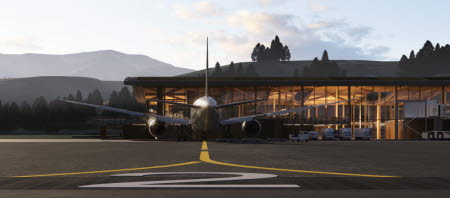29 Aug 2023
Preferred runway alignment released for proposed Central Otago Airport
Christchurch Airport has released 'Unlocking Potential: Central Otago’s runway to future-focussed aviation' which outlines the latest information on the exploration of a potential airport near Tarras.
The company is exploring the potential for a new regional airport to ease well-known air capacity constraints in the Central Otago region. The report released today outlines the need for increased air capacity, the preferred runway alignment and length, information on the environment around our site and contains analysis on the impact an airport could have on the land transport network – and the implications of not building additional air capacity.
The airport’s Chief Executive Justin Watson says the project is focussed on laying the groundwork for a good decision on the future of the project – whether an airport is built or not.
“We believe this is worth exploring. Our team has been working with experts to understand what the region might need in 20, 30 or 40 years and how a new Central Otago airport could support the social and economic wellbeing of the region,” he says.
“We know people in Central Otago are passionate about their place in the world and what happens to it. Its economy depends on the efficient movement of people and products, and while we’re not making decisions yet, we are making sure we fully understand the impact of the options both now and for future generations.”
The airport’s Chief Strategy and Stakeholder Officer Michael Singleton says demand for air connectivity to and from Central Otago is likely to far exceed the region’s current capacity over the next 30 years.
“This could result in the region spilling more passengers than it serves by 2040. Increasing capacity at existing infrastructure will only move the problem out a few years. This is likely to have a far greater impact on residents, as visitors are more likely to book earlier and pay higher fares,” he says.
“Demand for travel to and from Central Otago will continue to grow even if air capacity is constrained. Doing nothing about air capacity constraints will simply cause congestion and inefficient travel patterns.
“If we do nothing, there could be between two and three people vying for every available seat to and from the region by 2050.”
Expert analysis has led to a preferred runway alignment and a realistic range of runway lengths.
"A runway aligned to the Lindis Valley and Lake Dunstan stood out for its safety, operational efficiency and having a lesser noise impact on the communities in Central Otago. The alignment also provides greater flexibility for aircraft types, which is particularly important to enabling the next generation of low emissions."
- Michael Singleton, Chief Strategy and Stakeholder Officer
“Runway length is a key enabler for regional growth, connectivity, resilience and prosperity over the long term. This is why we spent time understanding the range of runway lengths realistically achievable on the site.
“Based on the information we’ve seen so far, a runway between 2,200 and 2,600 metres is likely to be feasible on the site and would provide Central Otago with infrastructure fit for a low carbon future.
“We now have a good idea of the size of the opportunity. Our focus is now sharpening and deepening as we build on this solid base of data and expert analysis.”
The project team will be in Central Otago to talk with people about the findings in the report. For more information visit centralotagoairport.co.nz
Additional materials
Images, videos and other material related to the release are available in this media kit.



